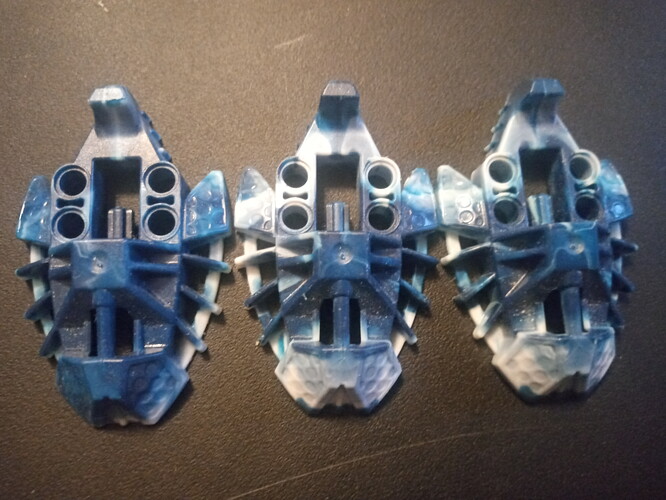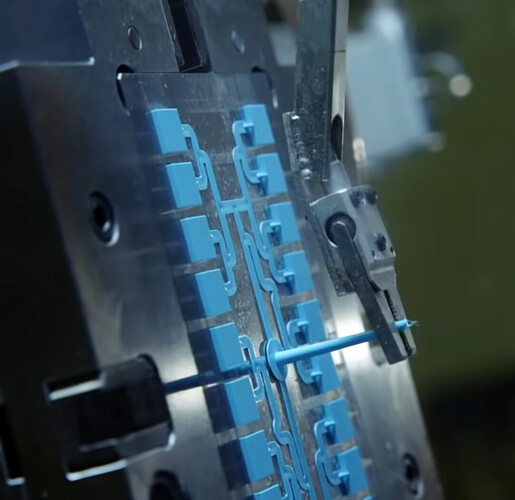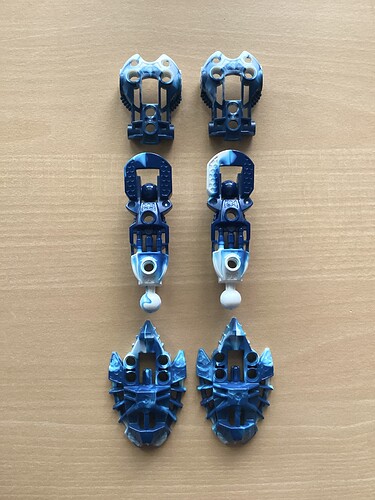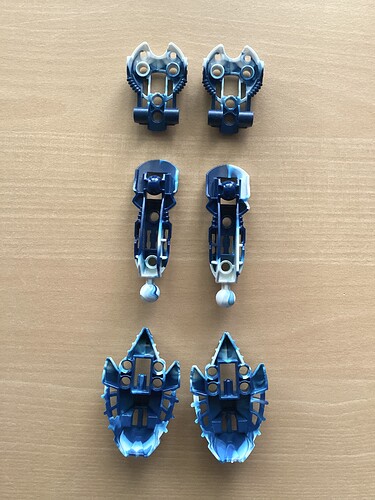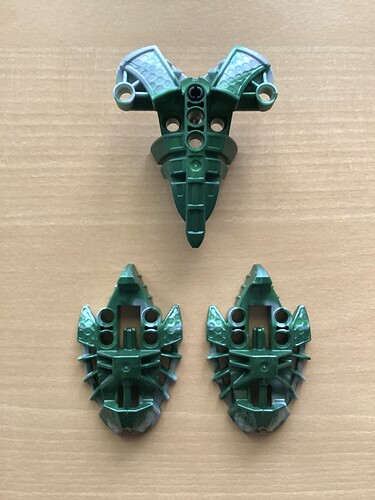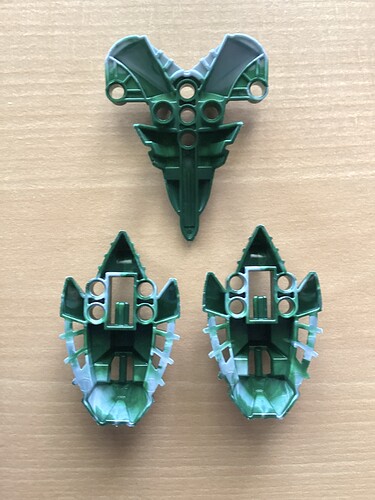My brother has a Hahli Inika figure that I’ve always found to be really cool. It wasn’t until recently, though, that I noticed the marbled parts were perfectly symmetrical with their marbling. Is this common with the marbled Inika parts, or is it just a coincidence?
It’s like that on my Hahli Inika as well.
My best guess would be that there were two symmetrical molds, and then each set took one from each mold. I wonder if the marbling between sets is identical as well.
I asked because I see lots of these parts on other users’ MOCs, and their parts are often asymmetrical in their marbling, though they may be using parts from copies of the same sets.
I’ve noticed with Hahli Inika’s shoulders (I have quite a few) there seems to be three distinct patterns that remain surprisingly consistent.
I wonder if these patterns were changed during production, or if different factories had a different process, or if there is another reason for their differences. I also wonder if there’s more patterns out there…
I looked into this last year. I have about 5 Hahlis, so I took a look at all their marbled pieces. From what I can recall, the leg pieces being marbled on the right was far more common than marbling on the left. Additionally, the ball joints for the ankles were white to different degrees. Some just had white swirls, while others were fully white.
Every leg had roughly the same pattern, regardless of which side the marbling was on.
An interesting thing is that the injection mark on the piece changes depending on which side the marbling is, meaning there were two separate molds in use.
That’s really neat! The Hahli my brother owns is perfectly symmetrical with the marbling, which I have never seen before except in promo ads. It did appear to me that the armor on his set was molded in two different molds, or on each side of the injector, as the armor is a mirror image on each side. Even the feet are mirror images!
Varies between my two Kongu and Hahli as well.
A set number of distinct patterns make sense; it’s the same thing commonly noted with the poisoned Hau Nuva variations. I’d recommend the explaination provided in this Eljay Johnsen show episode (timestamped).
This initially talks about Krana, which I have included for context, but it does move onto discussing multi-color parts.
(Note: This does not appear to hold true for the 2007 Sea Squids. It is unclear why.)
I’d imagine the differing side of the injection mark is due to the different positions in the mold. Afaik, all of these parts only have on element ID, implying one mold each.
The explanation is actually quite easy and @Wolk has already touched upon it.
Each mold has several positions for multiple parts and this is different for each element. When producing marbled pieces, two kinds of plastic/pigment are injected in a uniform manner and they travel throughout the mold. Depending on the position in the mold, some pieces recieve different quantities and/or distribution of component colors.
Since the injecting process is programmed to be as uniform as possible, this results in a population of pieces with similar marbeling.
Aside from element ID and LEGO symbol, pieces have another number indicating their position within the mold.
As said by @ToaKebaka, the marbling pattern would change if the two colours were injected at different times and/or volumes.
The fact that each set (apparently) came with symmetrical parts tells me that, at any given time and place, there was a single pair of molds making mirrored versions of the part by injecting identical volumes of colour at the same time, just from opposite sides of the mold.
The different patterns would come from different injection parameters, it’s just a question whether the parameters were changed by time, place, mold, or a combination of all three.
I suspect (and this is pure speculation) that, rather than injecting multiple colours at once from different points in the mold, the rubbers were instead mixed together externally, and injected into the mold directly afterwards. Then, the different colours and patterns come from random variation in the non-homogenous rubber mixture.
This is supported by the fact that, according to the post you linked, each squid only has a single injection mark.
I’m not so sure about this. If you look, I highlighted the fact that the secondary color tends to noticably flow from the injection point (check the squids in water pictures - especially first two squids). I would think that if they were mixed beforehand, this wouldn’t be observable and the distribution of the red dye would be much more randomized.
Also I’m not sure such prior mixing would even be possible as the plastic has to be really hot before injection.
Even more bizzare is the fact that the injection point bears the position number. Normally the injection point never bears any markings because, well how could it? These seem to be stamped after the initial injection although I don’t have any technical details on how that is done.
The squids are quite unique pieces 1) small, 2) rubbery, 3) very complex; so I would assume any unique manufacturing has to do with that.
EDIT: I checked my Hahli Inika and she has paired marbled parts with matching position numbers in legs and feet, but unpaired in shoulders. So it is not always 100% match.
As a minor detail, the molds use design ID as they are reused for different colors; element ID is the combination of design + color.
At least when it comes to the database, marbled parts typically do have unique design IDs from non-marbled ones. This does not appear to apply to the physical parts, as both Hahli’s and the non-marbled ones have the same ID(s) written inside them on one side of the inside of the knee: 53548
53548 is used in the database (to see this, I use Brickset) for non-marbled ones, the marbled ones are missing for this particular piece.
Strangely, they have a second 5-digit number as well, written on the opposite side from the design ID, 57473. This appears to be the marbled version’s ID, based on the following observations on the shoulder armor:
Looking at the shoulder armor’s design ID in the databse, it is 53544, however the marbled version is 57474. Much like the Inika leg piece, both of these are written inside the part.
As for the mold position numbers, these are written in the format of X-YY, where X is the position, and YY is the specific mold (as you can imagine with basic, common bricks, many molds are needed to be used). On the Inika leg piece, these are again located near the knee, on the inside of the knee guard.
Of note, I’ve noticed that Hahli’s marbled ones read X-01, while the solid colored ones read X-02. I am not sure if this is 100% consistent, however. Additionally, the “© 2005 LEGO Group” text is larger on the X-02 than it is on the X-01.
Looking at the Inika legs parts, the highest mold position I’ve found is 7, though it’s reasonable to assume it’s an even number, and as such, likely there’d be 8 positions.
For the Inika leg, my guess would be that it’d be set up something like this:
Of course, this is a rough estimation.
Whether you end up with a proper “mirrored” piece is probably 50/50; I definitely belive it’s an unintended side-effect, rather than an intentional design decision.
Either way, it looks great when it is properly mirrored.
I’ve always wandered how lego did the marbling for pieces like strakk’s helmet because they all have that ling thing through them, like how hard must it to be to get them all looking the same?
Not that hard at all. It is an automated process: same amounts of plastic, same injection pressure, same cooling etc.
To expand on @Wolk’s diagram, this is an example of (monocolored) plastic pathways used during LEGO injection molding.
As you can see, the amount of plastic each element mold recieves can be altered by adjusting the distance it has to travel. In this example the distances are equalized to make sure each element recieves full dose of plastic.
And this distance is generally what causes different patterns, from my understanding, as the distance may differ between the two colors.
I believe Zamors are a similar case to the squids, but given their lack of any form of numbers, it’s really hard to say.
